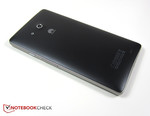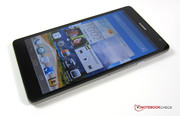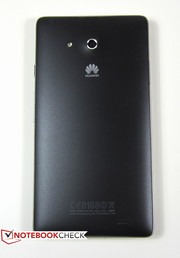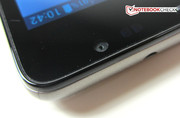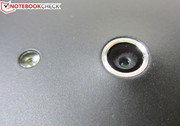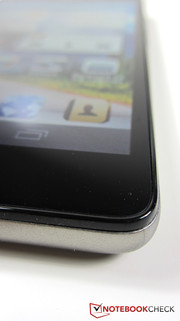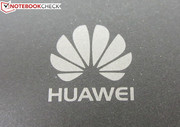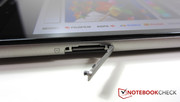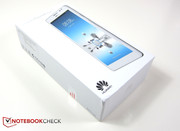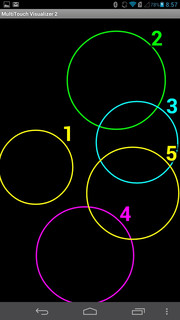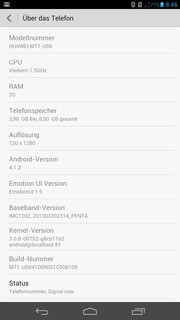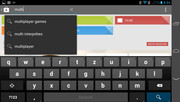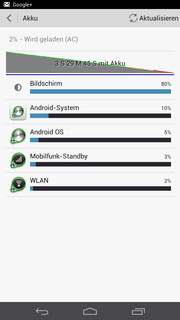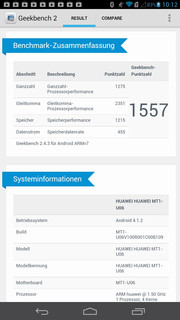Review Huawei Ascend Mate Smartphone

For the original German review, see here.
Although the Samsung Galaxy Note II GT-N7100’s exactly 5.55-inch display looked impressive enough, the Ascend Mate from Huawei goes above and beyond in this respect and thereby easily leads in the category of XXL smartphones: The Ascend Mate is equipped with an impressive 6.1-inch IPS+ LCD display (15.49-centimeters), which, although not equipped with Full HD resolution, can display the "small" HD resolution of 1280x720. The choice of case colors available is simply black, like our test device, or white – buyers must do without the colorful shades offered by the competition’s products. The usual price paid for the Huawei Ascend Mate is currently around 400 Euros (~$521).
Huawei’s Ascend Mate uses, as with their previous Ascend G615 and the Ascend D1 Quad XL, their own HiSilicon quad-core K3V2 processor, this time with a higher clock speed of 1.5 GHz. The operating system in use is Android OS version 4.1 Jelly Bean, which makes it the most current. Altogether the benchmarks have the makings of a convincing entrance. Our test will also soon show that the Ascend Mate shines in many regards, despite the few weaknesses that it carries with it.
With its considerable display size, the test subject set not only the new record for measurements (163.5 x 85.7 x 9.9 millimeter) but also for weight of a smartphone (198 grams). With close to a centimeter in thickness, the Ascend Mate is no lightweight, but nonetheless carries well in the hand. In direct comparison to similar large tablets it can be seen that the test subject is, with barely a centimeter thickness, in fact flatter than others such as the Asus Fonepad ME371MG (10.4 mm) and the Google Nexus 7 (10.5 mm).
A large amount of the successful surface feel is due to the matte polycarbonate finished case back with a prominent surface, which gives a secure grip for fingers and at no time gives the feeling that the XXL smartphone would slide out of the hands. Due to its large size, the Ascend Mate still requires both hands to use.
The build quality of the Ascend Mate leaves as little to be wished for as the smaller and already-tested devices from Huawei: Ascend G615, Ascend G600, and Ascend D1 Quad XL. The casing is as steady as a rock: neither pressure nor torsion attempts could impress the smartphone, or elicit any sounds to indicate the materials were strongly stressed. Only with exposure to high force could the case be minimally twisted, and only then the case back side could be twisted no more than approximately one millimeter.
The Ascend Mate’s non-removable battery provides another record value at 4,050 mAh, which gives hope for a long-lasting battery life. The large display could put a stop to that hope however, as it would take up a serious portion of the device’s total power consumption. Also contained in the case is a 1.0 megapixel resolution front camera as well as an 8.0 megapixel main camera on the back.
As already indicated at the beginning, the Ascend Mate uses the house brand HiSilicon quad-core K3V2 processor, with a clock speed of 1.5 GHz. The CPU assists the “16-core GPU” Vivante GC4000, combined with an opulent 2 GB RAM as well as 8 GB of internal storage, which can be extended to 32 GB via the Micro-SD slot.
The native resolution of the 6.1-inch display is 1280x720 and therefore no larger than similarly-sized smartphones, although the Samsung Galaxy Note II GT-N7100 (5.5-inches, 1280x720 pixels) provides another option. A look at the world of tablets also shows that the resolution of the Mate fits the usual mold: Asus Fonepad ME371MG (7-inches, 1280x800 pixels), the Google Nexus 7 (7-inches, 1280x800) or the Samsung Note 8.0 Tablet (8-inches, 1280x800). Only the Apple iPad Mini (7.9-inches, 1024x768 pixels) falls at a somewhat lower resolution than the others and has a 4:3 rather than a 16:9 or 16:10 aspect ratio.
The setup of buttons and cables is not surprising – all the important elements are available, and there are no prominent features. On the right side of the case are the on/off buttons and directly underneath, the volume controls. On the left side is the Micro SD port and on the top are a Micro SIM port and a 3.5 mm headphone jack. On the bottom edge of the Ascend Mate are the microphone and the Micro USB port.
Software
The OS used is Google’s operating system Android 4.1 Jelly Bean. Also installed is Huawei’s new graphical user interface EmotionUI, which should make use and app management of the Android device easier.
Communication & GPS
The Ascend Mate complies with all major 2G and 3G mobile communications standards and is also equipped by Huawei with an NFC module which is to be expected in this price range. Thanks to the Intel XMM 6260 platform, the Huawei can handle UMTS Network HSDPA speeds up to 21 Mbit/s and thereby allows speeds similar to DSL. HSUPA provides up to 5.76 Mbit/s. The Wi-Fi module is configured for radio connection according to the standard 802.11 b/g/n and in the test provided continually stable performance and worked without unplanned connection interruptions. Bluetooth is supported by the test subject in the version 4.0+EDR. GPS, A-GPS, and Glonass sensors are also integrated for precise location determination, which work smoothly under open sky, and fast orientation was also possible at the testing location inside closed rooms.
Cameras & Multimedia
The Huawei Ascend Mate includes a 1280x720 pixel resolution front webcam (1.0 MP) and an 8 megapixel main camera with autofocus as well as an LED flash. Both cameras can also shoot 720p format videos. The quality of the front camera leaves something to be desired in capturing both still and moving images because the capture is disrupted by heavy image noise, and due to the low resolution is only appropriate for video chats at best. Somewhat better is the 8 megapixel main camera, which still would not win a photo prize even in ideal lighting conditions. Photos appear at times with too pale colors, sometimes with too much contrast, and despite the autofocus and LED flash generally do not appear particularly sharp and are disrupted by image noise. A whole range of smartphones show examples of better performance, including the Apple iPhone 5, the Google Nexus 4 or the Nokia Lumia 920. In direct comparison however, the Ascend Mate does not do so badly and shoots thoroughly usable photos.
Accessories & Warranty
The package of the Huawei Ascend Mate includes a compact power adapter, which connects to the included Mini-USB cable. Also included are a quick-start guide and a standard stereo headset. Further accessories are not currently offered by the manufacturer. Huawei provides the Ascend Mate with a warranty of 24 months. An extension of the warranty is not available.
Input Devices & Usage
Use of the Ascend Mate is performed easily through a virtual QWERTY keyboard - as long as the input is of web addresses or short texts. Due to the large display, even in vertical orientation the individual buttons are displayed at a comfortable size, and of course even more so when the screen is turned horizontally.
Huawei has covered the basics with the touchscreen: the display reacts without noticeable delays to the input, the automatic orientation of the display takes place quickly, and the fingers glide comfortably without resistance across the glass surface. There are also no complaints with the three soft-touch buttons at the bottom of the display or the physical buttons like the on/off button or the volume control, which respond equally reliably. Overall, the result is an agile interface for the Ascend Mate without any critical snags.
A marketing promise by the name of “Magic Touch” is something we couldn't quite reproduce. According to Huawei, interaction with the smartphone display should also work while wearing thick leather gloves, for example. For this purpose there is a separate "Gloves Mode" Android setting, which is deactivated by default. During the test and with the gloves function activated, we could navigate the Android menus with neither leather nor thick fabric gloves, although under these circumstances fine motor skills fall by the wayside. Ultimately it comes down to which gloves and under what circumstances whether the exact inputs are possible. Occasionally the display surface had to be really pressed for the test subject to react, which significantly raises the fail rate of inputs.
The 6.1-inch display of the Huawei Ascend Mate is protected from damage by a Corning Gorilla Glass surface and successfully withstood every gentle scratch test. The resolution is classical at 1280x720, although one could have expected the largest smartphone yet to have a higher resolution.
With an average luminance of 471 cd/m², the Ascend Mate achieves an excellent result and thereby leaves the competition in the smartphone and tablet camp almost completely in the dust. Only a few devices like the Asus Transformer Pad Infinity arrive at a higher amount (534.6 cd/m²). Neither the Apple iPad Mini (337.7 cd/m²) nor the now second-largest smartphone Samsung Galaxy Note II (230.3 cd/m²) get close to the Huawei. Only the Samsung Tablet Note 8.0 manages a value nearly as good, with 449.2 cd/m². Greater orders are hindered only by the 0.6 cd/m² properly high black value of the Ascend Mate, which results in an average contrast ratio of 825:1.
| |||||||||||||||||||||||||
Brightness Distribution: 89 %
Center on Battery: 495 cd/m²
Contrast: 825:1 (Black: 0.6 cd/m²)
ΔE ColorChecker Calman: 5.44 | ∀{0.5-29.43 Ø4.79}
ΔE Greyscale Calman: 5.36 | ∀{0.09-98 Ø5}
Gamma: 2.44
Our measurements with a colorimeter and CalMAN software confirm the blue overtones typical of LED smartphone and tablet screens. Even the Huawei Ascend Mate proves no exception: its bluish colors vary the greatest from the sRGB color profile. In addition, the test subject cannot display the gray tones with low saturation optimally. In the end however, there are no large abnormalities to cause us to criticize any further. However, the color display is not one of the shining features of the Ascend Mate. In this respect, the really good example is the Samsung Galaxy S4.
The IPS panel of the Huawei smartphone makes sure that colors barely pale even with extreme viewing angles, and even the contrast and brightness survive. Of course at very extreme side views the colors do pale slightly, but in practical use that does not really play a role.
Smartphone and processor are both from the same manufacturer: Huawei uses the quad-core CPU HiSilicon K3V2, comprised of the four ARM Cortex A9 processors, in the Ascend Mate. With an active CPU core, the processor achieves a clock speed of 1.5 GHz, and with four simultaneously active cores, 1.2 GHz. The HiSilicon K3V2 is paired with the Vivante GPU GC4000 – a combination which not only sounds good, but also in practice hits the gas pedal equally with applications and games.
Since the Ascend Mate serves both the smartphone and tablet camps with its huge display, we compared it to devices in both domains. Against synthetic 3D benchmarks, the test subject showed similar performance to the Asus Fonepad ME371MG, the Google Nexus 7 as well as the Samsung Galaxy Note II GT-N7100 and the Samsung Galaxy Note 8.0 – the differences in performance were relatively small.
| 3DMark | |
| 1280x720 Ice Storm Standard Score (sort by value) | |
| Huawei Ascend Mate | |
| Asus Fonepad ME371MG | |
| Google Nexus 7 | |
| Samsung Galaxy Note 8.0 | |
| 1280x720 Ice Storm Standard Graphics (sort by value) | |
| Huawei Ascend Mate | |
| Asus Fonepad ME371MG | |
| Google Nexus 7 | |
| Samsung Galaxy Note 8.0 | |
| 1280x720 Ice Storm Standard Physics (sort by value) | |
| Huawei Ascend Mate | |
| Asus Fonepad ME371MG | |
| Google Nexus 7 | |
| Samsung Galaxy Note 8.0 | |
| Epic Citadel | |
| High Quality (sort by value) | |
| Huawei Ascend Mate | |
| Asus Fonepad ME371MG | |
| Samsung Galaxy Note 8.0 | |
| High Performance (sort by value) | |
| Huawei Ascend Mate | |
| Asus Fonepad ME371MG | |
| Google Nexus 7 | |
| AnTuTu v3 - Total Score (sort by value) | |
| Huawei Ascend Mate | |
| Asus Fonepad ME371MG | |
| Google Nexus 7 | |
| Samsung Galaxy Note 8.0 | |
| NenaMark2 - --- (sort by value) | |
| Huawei Ascend Mate | |
| Asus Fonepad ME371MG | |
| Google Nexus 7 | |
| Samsung Galaxy Note II GT-N7100 | |
| Samsung Galaxy Note 8.0 | |
| Geekbench 2 - 32 Bit - Total Score (sort by value) | |
| Huawei Ascend Mate | |
| Apple iPad mini | |
| Asus Fonepad ME371MG | |
| Google Nexus 7 | |
| Samsung Galaxy Note II GT-N7100 | |
| Samsung Galaxy Note 8.0 | |
Against the browser benchmarks, the Ascend Mate showed the best performance by far with Mozilla Kraken V1, but in further investigation with Octane V1 and Google V8 Ver.7 had to surrender to both Samsung tablets, the Galaxy Note II GT-N7100 and Galaxy Note 8.0, which in this case were somewhat faster. Nonetheless, no delays surfaced in the test of surfing the web, downloading, or searching the Google Play Store.
| Mozilla Kraken 1.0 - Total (sort by value) | |
| Huawei Ascend Mate | |
| Asus Fonepad ME371MG | |
| Samsung Galaxy Note 8.0 | |
| Octane V1 - Total Score (sort by value) | |
| Huawei Ascend Mate | |
| Asus Fonepad ME371MG | |
| Google Nexus 7 | |
| Samsung Galaxy Note 8.0 | |
| Google V8 Ver. 7 - Google V8 Ver. 7 Score (sort by value) | |
| Huawei Ascend Mate | |
| Apple iPad mini | |
| Asus Fonepad ME371MG | |
| Google Nexus 7 | |
| Samsung Galaxy Note II GT-N7100 | |
| Samsung Galaxy Note 8.0 | |
* ... smaller is better
Finally, the reading and writing performance of the smartphone: Even here, the Ascend Mate is equivalent in many areas to the chosen competition models. Overall, the data operations of the Samsung Galaxy Note 8.0 still succeed the best.
Games
The CPU/GPU team also assures that the Ascend Mate plays HD Video smoothly and provides sufficient support for current games. The test subject also had no problem with the graphically demanding titles. The games ran smoothly on the large screen and could be played perfectly by touchscreen as well as position and acceleration sensors.
Speech Quality
One can hardly believe it, but mobile phones were at one time used for nothing but phone calls. The Ascend Mate has not forgotten this and serves this purpose with a decent speech and hearing quality. That does not necessarily apply to the other end. While the speech quality in reception from another mobile device functions well, it declines if the receiving end is on a landline. In this situation there was also occasional soft background noise in the test conversation.
Temperature
The temperature changes of the Ascend Mate are confined to a narrow area, as long as the device is idle. Then the front side of the device heats to about an average of 30 °C and the back side stays cool at 28.7 °C. When under full workload the temperature on the top side of the display rises up to 47.4 °C, which leaves the average temperature at 37.1 °C.
This rise in temperature can be clearly felt, particularly when one makes a phone call and holds the device too close to the ear. As the processors of the Ascend Mate were just highly praised above, the rather strong temperature increase to more than 47 °C with long phone calls could become uncomfortable.
(-) The maximum temperature on the upper side is 47.4 °C / 117 F, compared to the average of 35.2 °C / 95 F, ranging from 21.9 to 247 °C for the class Smartphone.
(-) The bottom heats up to a maximum of 47.8 °C / 118 F, compared to the average of 34 °C / 93 F
(+) In idle usage, the average temperature for the upper side is 30 °C / 86 F, compared to the device average of 32.9 °C / 91 F.
Speakers
The Huawei giant's stereo speakers supply a good sound during telephone calls and are sufficiently loud. However, when it comes to playback of music, there's no joy due to the rather tinny sound pattern. The mids sound faded, the highs mostly shrill, and trying to hear the bass tones is ineffectual. The included stereo headphones provide a significantly better sound quality, since the integrated and already-activated sound profile Dolby Digital Plus in the default settings is responsible for good audio.
Power Consumption
The power consumption needs of the Huawei smartphone are more demanding than those of other devices. Thus the Ascend Mate uses between 2.1 and 3.9 watts when idling and 10.7 watts at full use. These values do not drag the judgment further because the test subject has a lithium-polymer battery with an enormous capacity of 4,050 mAh. With so much endurance, the Ascend Mate can redeem itself for drawing somewhat more power than others in the same comparison category. A small point of critique however, even when turned off we were able to measure 0.3 watts of power use, which slow as it may be, will eventually drain the battery.
| Off / Standby | |
| Idle | |
| Load |
|
Key:
min: | |
Battery Life
The high capacity of the battery is also reflected in a very good charge time: The maximum possible battery life, measured with our test settings (minimal display brightness, all power-saving features turned on, only Wi-Fi on), runs for a tremendous 23 hours and 22 minutes. The Samsung Galaxy Note II GT-N7100, until now the largest smartphone, could only achieve 14 hours and 36 minutes. In the Wi-Fi surfing test with a display brightness of 150 cd/m², the Ascend Mate could still reach a good 12 hours and 4 minutes. Under full load, the battery of the test subject still lasted 3 hours and 29 minutes.
With a 6.1-inch display, the Huawei Ascend Mate is the largest smartphone yet to run our test course. With its imposing screen diagonal, the price of about 400 Euros (~$521) is not draining at all for such a device. The Ascend Mate is so impressive through its very high luminance, which very few other smartphones can overtake and which allows users to use it outdoors in spite of the reflective IPS panel. In addition, there is the large viewing angle of the display and its precise and speedy reaction. In spite of its huge measurements, the case of the Huawei is very stable and allowed practically no twisting or deforming.
As it is equipped with 4.1 Jelly Bean and thus a current version of Android, the user can classify the Ascend Mate as either smartphone or tablet, since it can be used for either. Those who like to play smartphone games will be pleased with the powerful quad-core processor, and the large screen is ideal for watching HD videos. In addition, the Huawei is also fast in web browsing - for example, it can support up to 21 Mbit/s over UMTS network.
In the end, there are only two areas where the Huawei smartphone is not so impressive. Those would be the completely average image quality of the integrated cameras and the occasional soft background noise that we heard when phoning a landline, regardless of where we were standing. Altogether, the Ascend Mate imparts a really good attitude and is a looker with definitely more to offer than just a large display.






